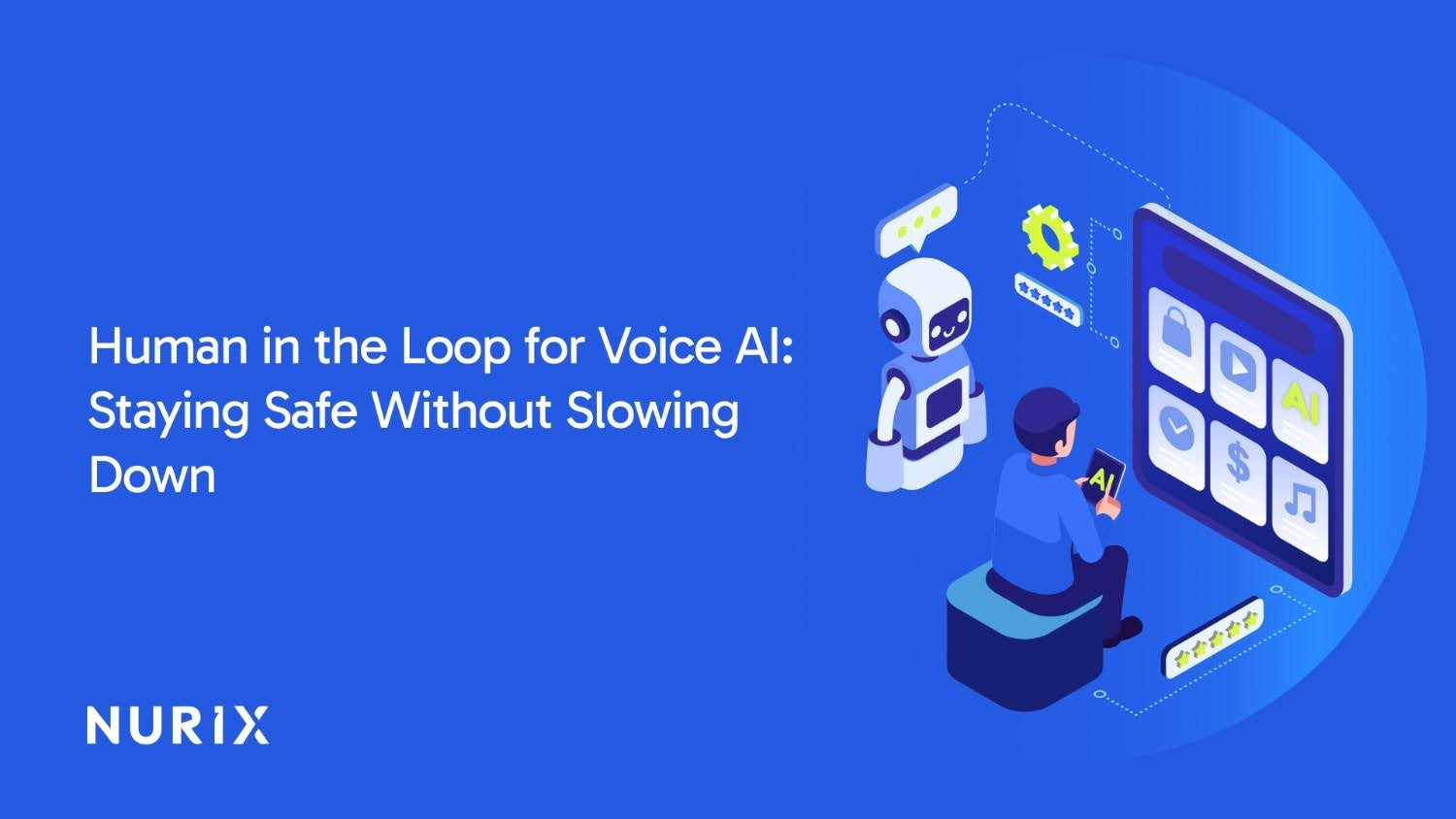Picture a large bank rolling out a new Voice AI assistant for day–to–day calls. Balance checks speed up, queues shrink, and customers finally stop waiting on hold for ten minutes. Then someone on the leadership team asks a simple question: “What happens if the AI gets a high value transaction wrong?” That single question is why a lot of enterprises hesitate to trust automation fully.
Most leaders are not afraid of Voice AI failing in small ways. They are afraid of it failing in ways that become screenshots, legal cases, or headlines. The fear is very real: wrong advice, risky decisions, compliance violations, or tone–deaf responses in sensitive moments. Human in the Loop, or HITL, exists to manage exactly this fear. The real challenge is not whether HITL is useful, but where you actually need it and how you design it so that safety does not kill speed.
What Human in the Loop Means for Voice AI
Human in the Loop (HITL) for Voice AI is a way of building workflows where humans stay inside the decision loop at key points. The AI handles most of the interaction, but humans step in to review, correct, or take over whenever the situation demands it. Instead of a fully black-box system, you have a layered system in which some decisions are automatic and others require human judgment.
In a typical Voice AI workflow:
- The customer speaks to the agent.
- The AI interprets the request and proposes a response or action.
- For low-risk, routine cases, the system completes the call on its own.
- For specific or sensitive scenarios, the call is routed to a human expert who sees the full context and makes the final decision.
This is common in sectors like healthcare, banking, and insurance, where a nurse, a fraud analyst, or a claims adjuster might step in at critical points.
The value of HITL comes from safety, oversight, and better handling of edge cases. Humans catch subtle issues that models miss and bring empathy into complex conversations. The tradeoff is that human review is slower, more expensive, and harder to scale. That is why it is important to avoid sending everything to a human and instead decide very clearly where HITL is genuinely required.
When Do You Actually Need HITL?
HITL is the slowest part of an automated Voice AI workflow, so it shouldn’t be the default. A practical way to decide when it’s needed is to look at four dimensions: risk, complexity, model confidence, and regulation. When one or more of these is high, HITL becomes easier to justify.
- Risk:
- If a wrong decision could cause financial loss, health issues, or legal trouble, HITL adds necessary protection.
- Examples: medical triage advice, high-value bank transfers, large insurance claims.
- Low-risk tasks like checking order status or answering FAQs rarely need human oversight.
- Complexity:
- If conversations involve exceptions, “it depends” logic, or multi-step decision-making, humans resolve them faster and more fairly.
- Examples: multi-step refunds, ambiguous complaints, telecom troubleshooting.
- Simple and structured tasks can stay fully automated.
- Model Confidence:
- Voice AI systems assign confidence scores. High confidence + low risk = safe for automation.
- Low confidence in sensitive workflows = escalate.
- E.g., an AI unsure about an insurance dispute or loan denial should hand it off instead of guessing.
- Regulation:
- Specific workflows legally require human oversight.
- Examples: KYC checks, GDPR data requests, HIPAA-sensitive interactions, payment verifications.
- In these cases, HITL is not a UX choice; it’s part of compliance and auditability.
Automatic and Manual HITL
Once you know which workflows need extra care, the next step is deciding how HITL should be triggered. In practice, Voice AI systems use two broad styles: automatic triggers controlled by the system and manual triggers initiated by humans.
Automatic HITL
Automatic HITL kicks in when specific conditions are met inside the system. These can include low confidence on intent detection, detection of sensitive topics like fraud or self harm, repeated failures to complete a task, or inconsistent information in what the customer is saying.
Some of these triggers are simple rules, such as escalating every transfer above a certain limit, while others come from models that detect anomalies or risky patterns.
Manual HITL
Manual HITL happens when either the customer or an internal user asks for a human. Customers might say, “I want to talk to an agent,” or “Can I speak to someone?” and the system should respect that. Supervisors might be monitoring a live dashboard, notice a conversation deteriorating, and decide to step in.
Agents themselves might take over when they see the AI looping or struggling with an unusual case. Manual escalation is often what protects relationships in moments of frustration.
Both types of HITL have a place in a mature system. Automatic triggers make sure you never miss hidden risks. Manual triggers give customers and staff a sense of control. Used together, they create a safety layer that is both systematic and human-friendly.
Getting HITL Right
HITL fails not when the AI routes to a human, but when the human joins the conversation blind. Everyone has experienced that painful moment where you explain your problem to a bot, get transferred, and the human says, “How can I help you today?” as if nothing happened. That is not just a UX flaw. It is a trust killer.
When a human takes over from a Voice AI, they should see the full story at a glance. That includes the conversation history, the customer’s identity and account context, what the AI thought the intent was, how confident it was, and what steps have already been attempted. They should also see any pending actions, partially completed forms, and relevant metadata like time, channel, and previous tickets. In a good system, the agent does not start from zero. They start from a position of context and momentum.
A bad handoff forces the customer to repeat themselves and makes the AI look useless. A good handoff feels almost magical. The agent greets the customer by name, already understands what they were trying to do, and finishes the remaining steps without wasting any time. This is where HITL turns from a safety feature into a customer experience advantage.
Turning Interventions into Learning
If you only treat HITL as a safety layer, you are missing half its value. Every time a human steps in, they are effectively telling you, “The model needed help here, and this is how I fixed it.” That is incredibly valuable training data.
Enterprises that take this seriously tag and analyze escalations. They look at where the model was confused, what the human changed, and what pattern sits behind that error. These cases become part of new training sets and evaluation benchmarks. Over time, the system needs fewer escalations for the same type of query and reaches higher confidence levels with less help.
The goal is not to eliminate HITL entirely. The goal is to make sure HITL gradually moves to the edges, where it handles rare, high risk, or deeply human scenarios, while the core flows become safer and more automated each month.
How NuPlay Approaches HITL
At NuPlay, we build Voice AI for enterprises that need both performance and protection. Our HITL designs focus on smooth transitions between AI and humans, with full conversation context preserved at every handoff. Agents see what the AI understood, how confident it was, and which paths it tried before escalation.
We give teams control over when HITL should trigger, whether through automatic thresholds or manual escalation. Human interventions are not just logged. They are turned into structured feedback that can flow back into model improvement cycles. Supervisors and compliance teams get clear dashboards, audit trails, and visibility into why specific calls escalated and how they were resolved.
The outcome is practical. You get a Voice AI system that handles the bulk of your volume with speed, but also knows exactly when to step aside and let a human take over. It does not just sound smart. It behaves responsibly, which is ultimately what enterprise-ready AI should do.










